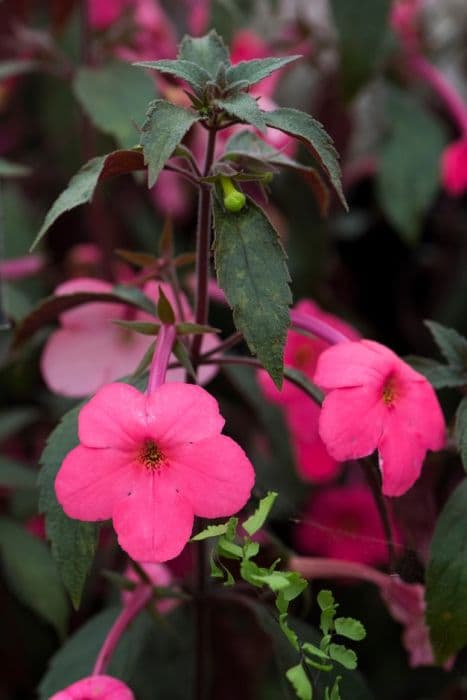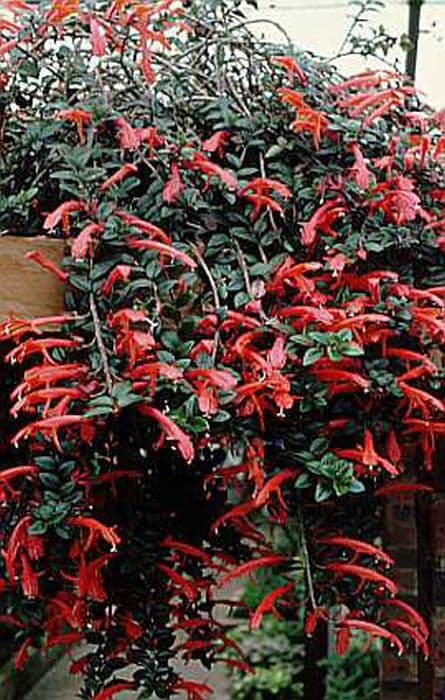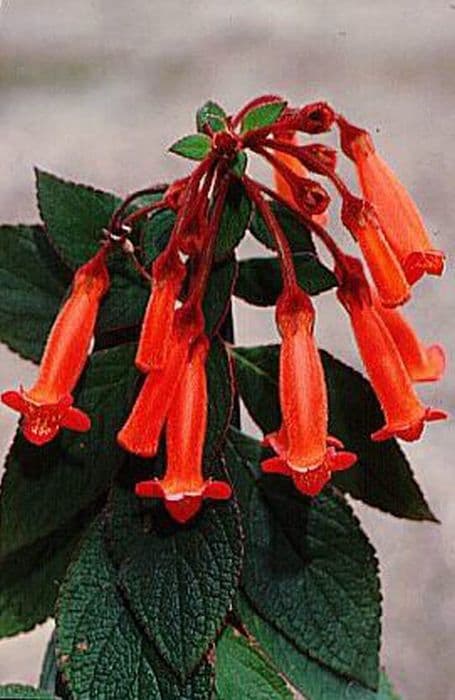Cape Primrose Streptocarpus 'Katie' (PBR)

ABOUT
Streptocarpus 'Katie' is a visually appealing houseplant, noted for its long, velvety leaves which present a deep green color. They are textured with fine hairs and a prominent vein structure that gives them a plush, almost ridged appearance. The flowers of this plant stand out with their tubular shape, coming in a beautiful array of violet hues often with delicate patterns or throat markings in contrasting white or yellow. They bloom in clusters at the end of fine, slender stalks which rise elegantly above the foliage. The overall impression of Streptocarpus 'Katie' is one of a lush and vibrant plant that can add a touch of floral drama to an indoor setting with its unique form and striking flowers.
About this plant
 Names
NamesFamily
Gesneriaceae
Synonyms
Cape Primrose, African Violet
Common names
Streptocarpus 'Katie' (PBR)
 Toxicity
ToxicityTo humans
Cape Primrose 'Katie' is generally considered non-toxic to humans. There are no well-documented cases of poisoning from ingesting this plant, and it is not known to carry significant toxic substances that would cause harm to humans if touched or ingested in small quantities.
To pets
Cape Primrose 'Katie' is also generally considered non-toxic to pets. It is unlikely to cause harm if pets ingest parts of this plant. However, individual animals may have sensitivities or allergic reactions to any plant, so it is always prudent to monitor pets and prevent them from ingesting plants not intended for consumption.
 Characteristics
CharacteristicsLife cycle
Perennials
Foliage type
Evergreen
Color of leaves
Green
Flower color
Purple
Height
1 feet 6 inches (45 cm)
Spread
1 feet (30 cm)
Plant type
Herb
Hardiness zones
10
Native area
Africa
Benefits
 General Benefits
General Benefits- Easy to care for: Streptocarpus 'Katie' is known to be a low-maintenance houseplant, perfect for busy individuals or those new to gardening.
- Long blooming period: This plant often blooms for several months of the year, providing extended enjoyment of its flowers.
- Variety of colors: It offers a range of flower colors, which can add a vibrant touch to indoor spaces.
- Compact size: Its modest size makes it ideal for windowsills, desks, and small spaces where larger plants might not fit.
- Shade tolerance: Streptocarpus 'Katie' can thrive in lower light conditions where other flowering plants might struggle.
- Attractive foliage: The plant has pretty, often textured foliage that remains attractive even when not in bloom.
- Enhances home decor: The colorful blooms can help to improve the aesthetic of a room and complement various decor styles.
 Medical Properties
Medical PropertiesThis plant is not used for medical purposes
 Air-purifying Qualities
Air-purifying QualitiesThis plant is not specifically known for air purifying qualities.
 Other Uses
Other Uses- Artistic inspiration: Streptocarpus 'Katie', with its striking flowers and foliage, can serve as a muse for artists and photographers, inspiring paintings, drawings, or photographic series that capture its beauty.
- Educational tool: Botany and horticulture teachers may use Streptocarpus 'Katie' to demonstrate principles of plant care, pollination, and hybridization to students.
- Color therapy: The vivid hues of Streptocarpus 'Katie' can be used in color therapy practices to create a calming environment that promotes relaxation and well-being.
- Collectible item: With its particular 'PBR' (Plant Breeders' Rights) status, this plant is a collectible specimen for plant enthusiasts who specialize in acquiring unique and patented plant varieties.
- Culinary decoration: Although not edible, the petals of Streptocarpus 'Katie' may be used as natural decorations on cakes and plates for special occasions to add a charming and colorful flourish.
- Phototropism demonstrations: The movement of Streptocarpus 'Katie' towards light can be used to illustrate phototropism in educational demonstrations about plant responses to light.
- Fashion design: The patterns and colors of Streptocarpus 'Katie' flowers can inspire textile patterns and color combinations in the fashion industry.
- Floral language and symbolism: Streptocarpus 'Katie' can be used as a means of silent communication to express feelings through the Victorian-era language of flowers, each color and form possibly holding a different connotation.
- Theme gardens: Gardeners can include Streptocarpus 'Katie' in themed garden displays that showcase hybrids or varieties with Plant Breeders' Rights for educational and ornamental purposes.
- Signature scents: While not typically known for a strong fragrance, subtle scents from Streptocarpus 'Katie' can be part of creating signature scents for spaces or events, contributing an original complexity to the olfactory experience.
Interesting Facts
 Feng Shui
Feng ShuiThe Cape Primrose is not used in Feng Shui practice.
 Zodiac Sign Compitability
Zodiac Sign CompitabilityThe Cape Primrose is not used in astrology practice.
 Plant Symbolism
Plant Symbolism- Persistence: Streptocarpus, also known as Cape primrose, can bloom continuously with proper care, symbolizing the value of tenacity and endurance.
- Adaptability: As a plant that can thrive both indoors and in shaded conditions, Cape primrose represents the ability to adapt to various environments.
- Optimism: The bright and colorful flowers of Cape primrose signify optimism and a positive outlook, often used to lift spirits in decorative settings.
- Diversity: With its many hybrids and varieties, Cape primrose reflects diversity and the beauty of unique characteristics.
 Water
WaterCape primrose prefers to be watered when the top inch of soil feels dry to the touch. Typically, it might need watering once a week, but this can vary depending on environmental conditions such as temperature and humidity. Use lukewarm water and aim to water directly onto the soil to avoid wetting the leaves, which can lead to fungal diseases. Each watering session should provide enough water so that it just starts to drain through the bottom of the pot – for an average-sized pot, this might be around 8 to 16 ounces.
 Light
LightCape primrose thrives in bright, indirect sunlight. A north-facing or east-facing window would be ideal for providing the gentle morning sunlight or diffused light without the harsh afternoon rays. Avoid placing the Cape primrose in direct sunlight, especially during the hot summer months, as this can scorch its leaves and fade the flowers.
 Temperature
TemperatureCape primrose performs well in typical indoor temperature ranges, ideally between 60 to 75 degrees Fahrenheit. It's important to keep the plant away from drafts, heating vents, and air conditioners to prevent sudden temperature fluctuations. The Cape primrose can tolerate a minimum temperature of about 50 degrees Fahrenheit, but prolonged exposure to temperatures below this can be detrimental to the plant's health.
 Pruning
PruningPrune Cape primrose to remove any yellowing or dead leaves and spent flowers to encourage new growth and a tidier appearance. The best time to prune is immediately after the blooms have faded. Pruning can be done sporadically throughout the year as needed, but a more thorough tidying is beneficial in late winter or early spring, just before the new growing season begins.
 Cleaning
CleaningAs needed
 Soil
SoilThe best soil mix for Cape Primrose is a well-draining one with perlite or vermiculite mixed into a peat-based or loam-based growing medium. Aim for a soil pH of around 6.0 to 7.5.
 Repotting
RepottingCape Primrose should be repotted annually or when it has outgrown its pot, usually after blooming or in the spring.
 Humidity & Misting
Humidity & MistingCape Primrose thrives at a humidity level of about 50%, which is slightly higher than average room humidity.
 Suitable locations
Suitable locationsIndoor
Place in bright, indirect light and maintain moderate moisture.
Outdoor
Preferable in dappled shade, sheltered from intense sun and wind.
Hardiness zone
10-11 USDA
 Life cycle
Life cycleStreptocarpus 'Katie', commonly known as Cape primrose, begins its life cycle when seeds germinate in warm, moist soil conditions, typically in spring or early summer. The seedlings quickly develop into rosettes of velvety leaves, a stage where they focus on vegetative growth and establish a strong root system. As the plant matures, usually within a few months, it begins the flowering stage, producing delicate tubular flowers that can vary in color, often in shades of blue, purple, or white. After pollination, the flowers will fade and seed pods, or 'twisted pods' (which the genus name Streptocarpus derives from), will form and mature, eventually drying and releasing seeds for reproduction. Some Cape primroses can also propagate vegetatively through leaf cuttings, where a portion of a leaf develops roots and grows into a new plant. Over time, typically after several years, the parent plant may decline in vigor, at which point it has completed its life cycle, though its progeny may continue through seeds or cuttings.
 Propogation
PropogationPropogation time
Spring-Early Summer
The most popular method of propagation for Streptocarpus 'Katie', commonly known as Cape Primrose, is by leaf cuttings. This is usually done in spring or early summer when the plant is actively growing. A healthy leaf is selected and cleanly cut from the plant with a sharp knife or scissors. The leaf is then laid flat and sectioned into pieces, each piece containing a vein. These sections are placed vein-side down in a moist, well-draining soil mix, ensuring that the soil is lightly firmed around them. The container with the leaf cuttings is placed in a warm, bright area, avoiding direct sunlight, and kept consistently moist. Roots and new shoots will develop from the veins, and once they have grown sufficiently – typically after a few weeks – they can be potted up individually into their own containers.









